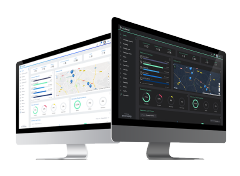
Air pollution & fine particles emissions
Sustainability | Environment | PollutionAtmospheric pollution is made up of fine particles suspended in the air (emitted by diesel vehicles) that seriously damage our health.
WHO stated in 2013 that general outdoor air pollution and specially the smoke produced by diesel combustion are carcinogenic to humans, and the particles in the air are closely linked to the increase in cancer of recent years, mainly lung cancer.
No further from reality, in 2016, 91% of the world's population lived in places where the WHO Guidelines on air quality were not respected. And this meant that, in the same year, there were 4'2 million premature deaths linked to atmospheric pollution, both in cities and in rural areas.
This mortality is due to exposure to small particles of 2.5 microns or less (detailed below), which cause cardiovascular, respiratory and cancer diseases, especially lung ones. And in the case of Spain, we talk about 30,000 premature deaths, almost thirty times more than the deaths caused by traffic accidents. In addition, it was estimated that 91% of these deaths occurred in low and middle income countries, where they suffer much more heavily the burden from the atmospheric pollution.
The WHO Air Quality Guidelines were published in 2005 and offer limits for air pollutants that cause health risks. These guidelines apply worldwide and are based on the evaluation of particles (PM), ozone (O3), nitrogen dioxide (NO2) and sulfur dioxide (SO2). Currently, the guidelines are under review and will be published again in 2020.
Therefore, as the levels of air pollution decrease, the better the cardiovascular and respiratory health of the whole society, both in the long and short term, thus reducing morbidity due to strokes and lung cancers, among others.
What about particles?
PM (Particulate Matter) is the acronym that represents those airborne particles (dust, smoke, carbon, etc.), generated mainly by combustion vehicles, whose consequences are increasing pollution. The unit of measurement is usually micrometers or microns. Its main components are usually sulfates and nitrates, ammonia, sodium chloride...
Thus, PMs are representative indicators of air pollution and are the particles that most affect people, more than any other type of pollutant, since they are considered the invisible threat of the human being. Those that are more than 50 microns in diameter can still be seen, but as they get smaller, they go unnoticed.
Particles containing less than 10 microns begin to be dangerous to our health as they can be inhaled and penetrate our lungs. But those under 2.5 microns and even submicron’s (less than PM1) are those that present a greater risk to society, since they are suspended fine particles that our respiratory system is not able to filter, so they are breathable and inhalable and able to penetrate our blood system.
In short, there are multiple types of polluting particles, but the main emitter of nitrogen dioxide is the car by generating the pollution beret that can be seen in large cities. This gas is emitted with diesel engines and occupies 46% of the total emissions of suspended particles in the European Union, according to a report by the European Environment Agency (Aema).
However, the risk to our health does not end in exposure to these particles, but also affect us ozone (O3) and sulfur dioxide (SO2). And as in the case of particles, the highest concentrations of all these elements are found mostly in urban areas.
Promoting a more sustainable mobility
The reduction of the micro particles and the consequent improvement of the air quality requires the reduction of the combustion vehicles until their complete disappearance.
A necessary measure for this is to prohibit, by administrations, the entry into the cities of combustion vehicles, especially diesel ones, as it will lead to a major reduction in pollution. Proof of this are the pollution protocols that have been carried out in large cities and have already paid off. For example, Paris, Madrid and Mexico City have committed to prohibit the circulation of diesel from 2025.
What are the most viable options?
The new sustainable mobility alternatives go through the use of public transport, electric vehicles and personal mobility vehicles such as scooters and electric bikes.
Car sharing and bike sharing concepts are growing exponentially and can help eliminate up to 15 private combustion vehicles for each rental car and reduce up to 50% of the gases emitted by the traffic generated from these vehicles.
And finally, a change in the urban model could be the icing on the cake, since society currently has an absolute dependence on the private car. And a change in the urban configuration could mean a considerable increase in the bike lane, shops and nearby schools, more frequent public transport, etc.
And all this for what purpose? Simply by taking care of ourselves more and better!
💙 And how Place to Plug contributes to the environment and sustainability?
By empowering you to use electric vehicles offering an end to end solution for the entire EV charging industry, whether if you are an EV driver, a developer, a business or an institution!


Leave a comment
Comments ( 1 )
Thank you for sharing!! To explore further https://www.360iresearch.com/library/intelligence/air-pollution-control-system